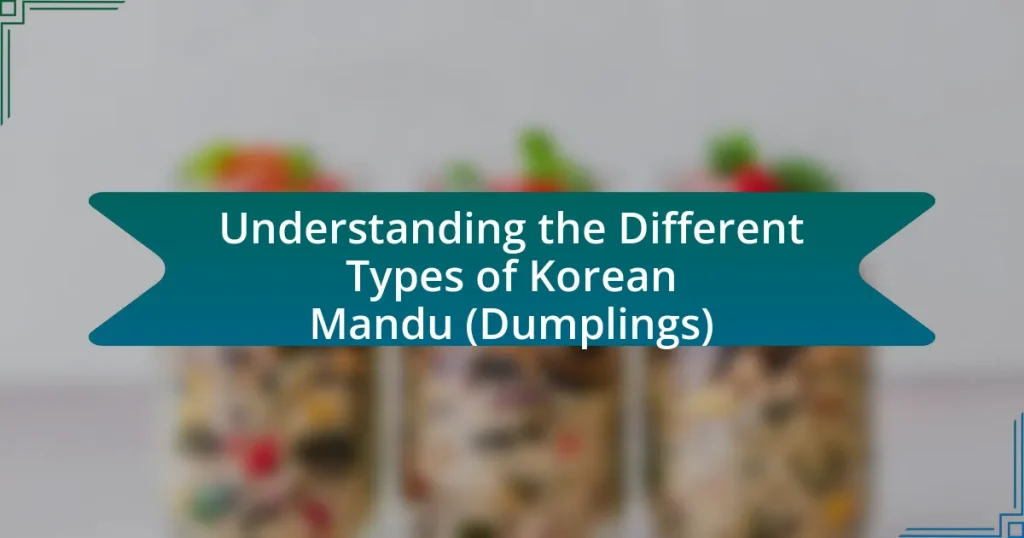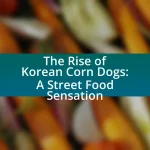Korean mandu, a traditional dumpling, comes in various types, including steamed (jjin mandu), fried (gun mandu), boiled (mul mandu), and mandu jjigae (dumpling soup). These dumplings are classified based on cooking methods and fillings, which can include ground meat, tofu, and a variety of vegetables. Regional variations across Korea introduce unique ingredients and preparation styles, reflecting local culinary traditions. Mandu holds cultural significance, often symbolizing prosperity during celebrations like Lunar New Year and Chuseok, and is a staple in Korean cuisine, enjoyed for its versatility and rich flavors. The article explores the different types of mandu, their preparation methods, common ingredients, and their role in Korean culture and cuisine.
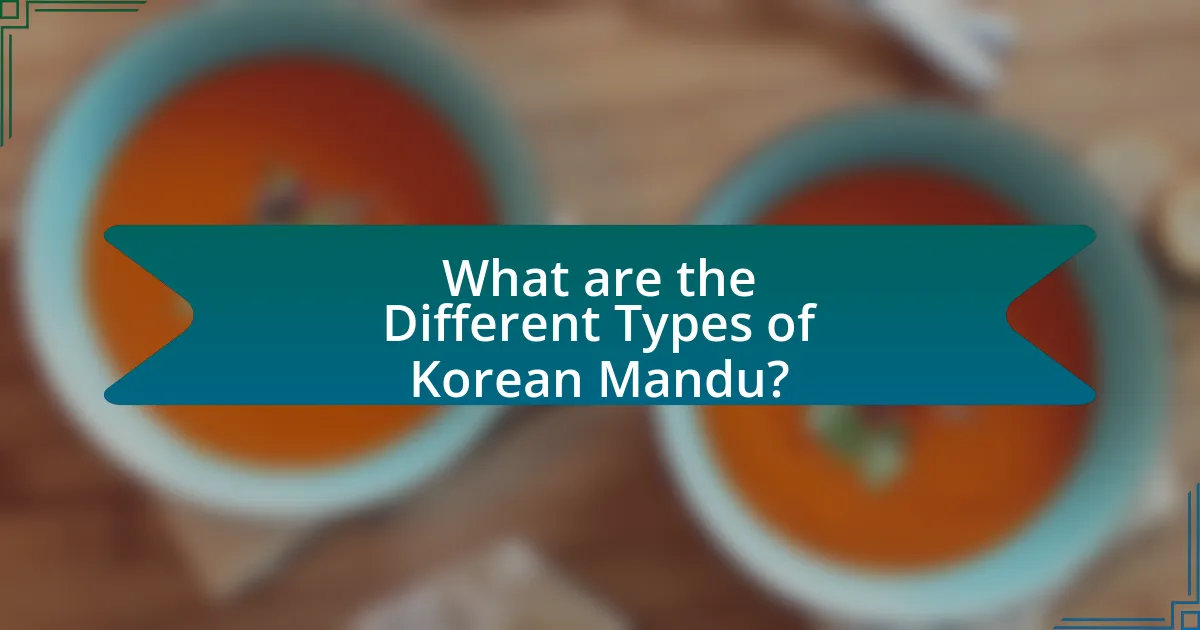
What are the Different Types of Korean Mandu?
The different types of Korean mandu include steamed mandu, fried mandu, boiled mandu, and mandu jjigae (dumpling soup). Steamed mandu, known as “jjin mandu,” is typically filled with a mixture of meat and vegetables and is cooked in a steamer. Fried mandu, or “gun mandu,” is pan-fried or deep-fried, resulting in a crispy exterior. Boiled mandu, referred to as “mul mandu,” is cooked in water and often served in broth. Mandu jjigae is a soup that features mandu as a key ingredient, often accompanied by vegetables and tofu. Each type showcases unique cooking methods and flavors, reflecting the versatility of mandu in Korean cuisine.
How are Korean Mandu classified?
Korean Mandu are classified primarily into two categories: steamed and fried. Steamed Mandu, known as “jjin mandu,” are cooked using steam, resulting in a soft texture, while fried Mandu, referred to as “gun mandu,” are pan-fried or deep-fried, creating a crispy exterior. This classification is based on the cooking method, which significantly affects the texture and flavor of the dumplings. Additionally, Mandu can also be categorized by their fillings, which may include meat, vegetables, or a combination of both, further diversifying the types available in Korean cuisine.
What are the main categories of Mandu?
The main categories of Mandu are steamed, boiled, pan-fried, and deep-fried. Steamed Mandu, known as “jjin mandu,” retains moisture and is often filled with vegetables and meat. Boiled Mandu, or “mul mandu,” is typically served in broth and can include various fillings. Pan-fried Mandu, referred to as “gun mandu,” has a crispy exterior and is cooked in a skillet. Deep-fried Mandu, known as “twigim mandu,” is fully submerged in oil, resulting in a crunchy texture. Each category showcases different cooking methods and textures, contributing to the diversity of this traditional Korean dish.
How does the preparation method influence Mandu types?
The preparation method significantly influences the types of Mandu by determining their texture, flavor, and cooking style. For instance, steamed Mandu, known as “jjin mandu,” typically has a soft and moist texture, while pan-fried Mandu, or “gun mandu,” achieves a crispy exterior through frying. Additionally, boiled Mandu, referred to as “mul mandu,” offers a different mouthfeel and is often served in soups. Each preparation method not only alters the physical characteristics of the Mandu but also affects the overall taste experience, as the cooking technique can enhance or diminish the flavors of the fillings used.
What ingredients are commonly used in Korean Mandu?
Korean Mandu commonly includes ingredients such as ground meat (typically pork or beef), tofu, vegetables (like cabbage, garlic, and green onions), and seasonings (including soy sauce and sesame oil). These ingredients create a flavorful filling that is wrapped in a thin dough made from wheat flour. The combination of these elements is essential for achieving the traditional taste and texture associated with Mandu, which is a staple in Korean cuisine.
Which proteins are typically found in Mandu fillings?
Mandu fillings typically contain proteins such as ground pork, beef, chicken, or tofu. These proteins are commonly used due to their flavor and texture, which complement the other ingredients in the dumplings. Ground pork is particularly popular in many traditional recipes, while beef and chicken offer alternative options for varying tastes. Tofu serves as a plant-based protein source, catering to vegetarian preferences.
What vegetables are popular in Mandu recipes?
Popular vegetables in Mandu recipes include napa cabbage, scallions, garlic, and mushrooms. Napa cabbage is often used for its texture and flavor, while scallions add a fresh, mild onion taste. Garlic enhances the overall flavor profile, and mushrooms contribute umami richness. These vegetables are commonly combined with meat or tofu in various Mandu preparations, reflecting traditional Korean culinary practices.
What are the regional variations of Mandu in Korea?
Mandu in Korea exhibits several regional variations, each characterized by unique ingredients and preparation methods. For instance, in Seoul, mandu is often filled with a mixture of ground pork, tofu, and vegetables, while in the Jeolla region, the dumplings may include seafood and a variety of local greens, reflecting the coastal influence. Additionally, the Gyeongsang region is known for its spicy mandu, incorporating gochugaru (red pepper flakes) into the filling. These variations highlight the diverse culinary traditions across Korea, influenced by geography and local ingredients.
How does the style of Mandu differ between regions?
The style of Mandu varies significantly between regions in Korea, with each area showcasing unique ingredients and preparation methods. For instance, in North Korea, Mandu often features a thicker dough and is typically filled with a mixture of ground meat, vegetables, and sometimes tofu, reflecting the region’s agricultural practices. In contrast, South Korean Mandu tends to have a thinner skin and may include a wider variety of fillings, such as seafood or kimchi, highlighting the diverse culinary influences present in the south. Additionally, regional variations can be seen in cooking methods; for example, some areas prefer steaming their Mandu, while others opt for frying or boiling, which further distinguishes the styles across the country.
What unique ingredients are used in regional Mandu?
Regional Mandu features unique ingredients that vary by area, such as kimchi in Jeonju Mandu, which adds a spicy and tangy flavor, and mung bean sprouts in Seoul Mandu, providing a crunchy texture. Additionally, Busan Mandu often includes seafood, particularly shrimp or fish, reflecting the coastal region’s culinary influences. These specific ingredients highlight the diversity of flavors and textures found in different types of Mandu across Korea.
How do cooking methods affect the taste of Mandu?
Cooking methods significantly affect the taste of Mandu by altering its texture and flavor profile. For instance, steaming Mandu results in a soft and moist dumpling, allowing the filling’s flavors to meld harmoniously, while frying creates a crispy exterior that adds a contrasting texture and enhances the overall taste through caramelization. Boiling, on the other hand, can dilute flavors if not seasoned properly, but it maintains a tender texture. Each method influences the sensory experience, making the choice of cooking technique crucial for achieving the desired taste in Mandu.
What are the most popular cooking methods for Mandu?
The most popular cooking methods for Mandu are steaming, boiling, and pan-frying. Steaming is commonly used to retain moisture and enhance the flavor of the filling, while boiling allows for a softer texture. Pan-frying, often referred to as “mandu-gui,” creates a crispy exterior, making it a favored method for many. Each method highlights different aspects of Mandu, contributing to its versatility in Korean cuisine.
How does steaming compare to frying Mandu?
Steaming Mandu results in a softer texture and retains more moisture compared to frying, which creates a crispy exterior. Steamed Mandu is often considered healthier due to lower fat content, as it requires no oil, while fried Mandu absorbs oil during cooking, increasing its calorie count. Studies indicate that steaming preserves more nutrients, making it a preferred method for those seeking a nutritious option.
What are the benefits of boiling Mandu?
Boiling Mandu offers several benefits, primarily enhancing its texture and flavor while ensuring food safety. The boiling process cooks the dumplings evenly, resulting in a tender and moist filling, which is often made from ingredients like meat and vegetables. Additionally, boiling helps to retain the nutrients in the filling, as it minimizes the loss of vitamins and minerals compared to other cooking methods like frying. Furthermore, boiling reduces the amount of added fat, making the dish a healthier option. This method also allows for the dumplings to absorb the flavors of the broth or water, enhancing the overall taste experience.
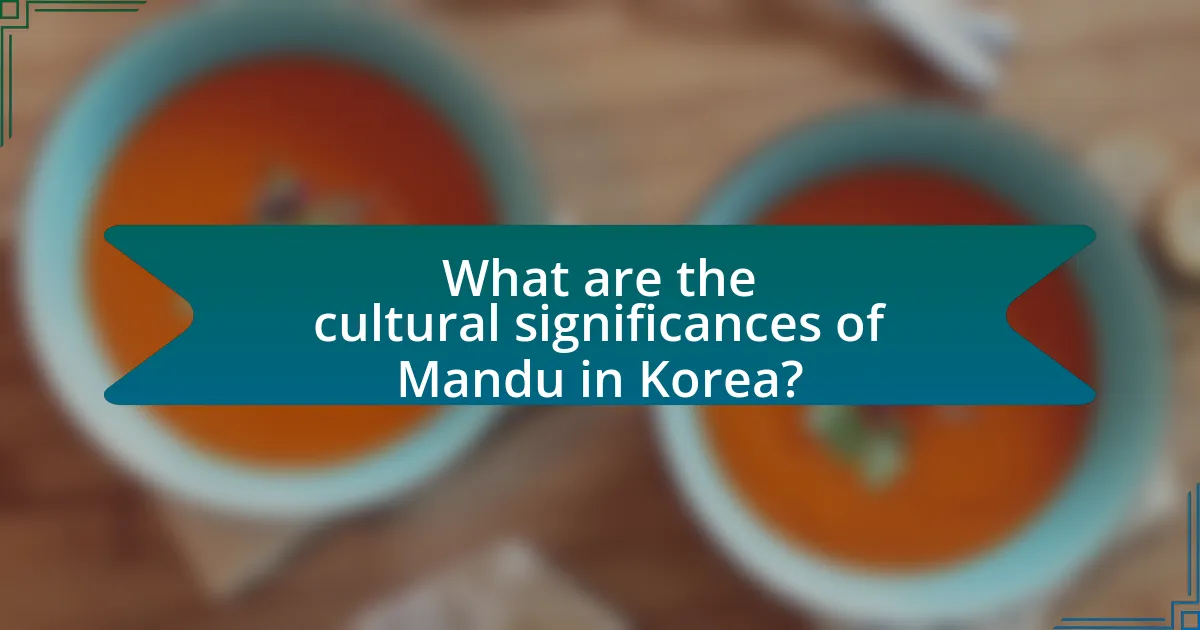
What are the cultural significances of Mandu in Korea?
Mandu holds significant cultural importance in Korea as a traditional dumpling that symbolizes prosperity and good fortune. Historically, mandu has been associated with celebrations and special occasions, such as Lunar New Year, where it is often served in a soup called mandu-guk, representing the wish for a prosperous year ahead. Additionally, the preparation and sharing of mandu foster communal bonds, as families often gather to make these dumplings together, reinforcing social ties and cultural heritage. The variety of fillings and cooking methods also reflect regional diversity and local ingredients, showcasing the adaptability and richness of Korean culinary traditions.
Why are Mandu important in Korean celebrations?
Mandu are important in Korean celebrations because they symbolize prosperity and good fortune. Traditionally, these dumplings are prepared during significant holidays such as Lunar New Year and Chuseok, where families gather to make and share them. The act of making mandu together fosters family unity and reflects cultural values of sharing and abundance. Additionally, the shape of mandu, often resembling gold ingots, reinforces their association with wealth and success in the coming year.
What traditional occasions feature Mandu?
Mandu is traditionally featured during significant Korean occasions such as Lunar New Year (Seollal) and Chuseok, the harvest festival. During Seollal, families prepare mandu as part of the celebratory meal, symbolizing prosperity and good fortune for the coming year. Similarly, during Chuseok, mandu is made to honor ancestors and is often included in the feast that celebrates the harvest. These occasions highlight the cultural importance of mandu in Korean culinary traditions, reinforcing its role in family gatherings and festive celebrations.
How do families incorporate Mandu into their cultural practices?
Families incorporate Mandu into their cultural practices primarily during significant celebrations and family gatherings, such as Lunar New Year and weddings. During these occasions, the preparation and sharing of Mandu symbolize unity and prosperity, reflecting traditional values. For instance, the act of making Mandu together fosters family bonding and allows for the transmission of culinary skills and cultural heritage across generations. Additionally, specific types of Mandu, like steamed or fried variations, may be prepared to honor regional customs or family recipes, further embedding Mandu into the cultural identity of Korean families.
What role does Mandu play in Korean cuisine?
Mandu serves as a significant component of Korean cuisine, functioning as a versatile dumpling that can be filled with various ingredients such as meat, vegetables, and tofu. This dish is not only a staple in traditional meals but also plays a crucial role in celebrations and gatherings, often symbolizing prosperity and good fortune. Historically, mandu has been enjoyed since the Goryeo Dynasty, reflecting its deep-rooted presence in Korean culinary culture. Its preparation methods, which include steaming, boiling, and pan-frying, further showcase its adaptability and importance in both everyday and festive dining.
How is Mandu served in traditional Korean meals?
Mandu is typically served in traditional Korean meals either steamed, boiled, or pan-fried. In many households, it is accompanied by a dipping sauce made from soy sauce, vinegar, and sesame oil, enhancing its flavor. Mandu is often included in soups, such as mandu-guk, especially during celebrations like the Lunar New Year, where it symbolizes prosperity and good fortune. The preparation and serving methods reflect cultural significance, as mandu is a staple in Korean cuisine, enjoyed for its versatility and rich fillings.
What are common side dishes paired with Mandu?
Common side dishes paired with Mandu include kimchi, pickled radish, and a variety of dipping sauces such as soy sauce or vinegar-based sauces. Kimchi, a staple in Korean cuisine, complements the flavors of Mandu and adds a spicy, tangy element. Pickled radish provides a crunchy texture and a refreshing contrast to the dumplings. Dipping sauces enhance the overall taste experience, allowing for customization based on personal preference. These side dishes are frequently served in Korean meals, reinforcing their popularity alongside Mandu.
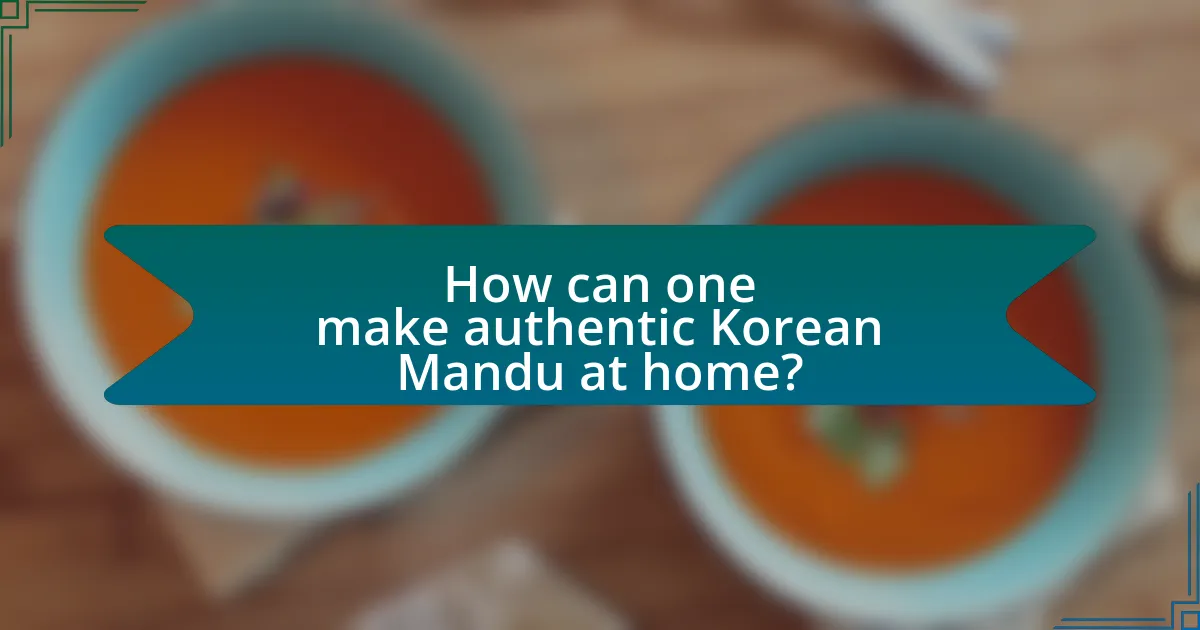
How can one make authentic Korean Mandu at home?
To make authentic Korean Mandu at home, start by preparing the filling, which typically consists of ground pork, tofu, garlic, green onions, and sesame oil. Combine these ingredients in a bowl and season with salt and pepper. Next, make the dough by mixing flour and water until it forms a smooth consistency, then roll it out thinly and cut into circles. Place a spoonful of the filling in the center of each circle, fold the dough over to create a half-moon shape, and seal the edges by pinching them together. Finally, cook the Mandu by steaming, boiling, or pan-frying until they are fully cooked. This method reflects traditional practices, as Mandu has been a staple in Korean cuisine for centuries, often enjoyed during celebrations and family gatherings.
What are the essential steps to prepare Mandu?
To prepare Mandu, the essential steps include making the dough, preparing the filling, assembling the dumplings, and cooking them. First, combine flour and water to create a smooth dough, then let it rest. Next, mix ground meat, vegetables, and seasonings to create the filling. After that, roll out the dough into thin circles, place a spoonful of filling in the center, fold the dough over, and seal the edges. Finally, cook the Mandu by steaming, boiling, or pan-frying until they are fully cooked. These steps are fundamental to creating traditional Korean Mandu, which is a popular dish known for its versatility and flavor.
How do you make the Mandu dough from scratch?
To make Mandu dough from scratch, combine 2 cups of all-purpose flour with 1/2 teaspoon of salt in a bowl. Gradually add about 3/4 cup of warm water while mixing until a dough forms. Knead the dough on a floured surface for approximately 10 minutes until it becomes smooth and elastic. Cover the dough with a damp cloth and let it rest for at least 30 minutes before rolling it out. This method is validated by traditional Korean cooking practices, which emphasize the importance of resting the dough to achieve the desired texture for dumplings.
What are the best practices for filling and folding Mandu?
The best practices for filling and folding Mandu involve using a balanced filling, ensuring the wrapper is moist, and employing proper folding techniques. A balanced filling typically includes a mix of proteins, vegetables, and seasonings, which enhances flavor and texture. Keeping the Mandu wrapper slightly moist prevents it from tearing during the folding process. When folding, it is essential to create a tight seal to avoid leakage during cooking; this can be achieved by pinching the edges firmly and using pleats for added security. These practices ensure that the Mandu is flavorful, well-structured, and retains its integrity during cooking.
What tips can enhance the Mandu-making experience?
To enhance the Mandu-making experience, focus on using fresh ingredients, as they significantly improve flavor and texture. Fresh vegetables, high-quality meats, and homemade dough contribute to a superior taste. Additionally, mastering the folding technique is crucial; precise folds ensure that the dumplings seal properly and maintain their shape during cooking. Experimenting with various fillings, such as kimchi or tofu, can also add unique flavors and cater to different dietary preferences. Finally, cooking methods like steaming or pan-frying can alter the texture and taste, allowing for a personalized Mandu experience.
How can you customize Mandu fillings to suit your taste?
You can customize Mandu fillings to suit your taste by selecting various ingredients such as proteins, vegetables, and seasonings. For instance, you can use ground pork, beef, or tofu as the protein base, and add vegetables like cabbage, mushrooms, or carrots for texture and flavor. Additionally, incorporating seasonings such as garlic, ginger, soy sauce, or sesame oil allows for further personalization. This flexibility in ingredient choice enables you to create a filling that aligns with your flavor preferences and dietary needs.
What are some common mistakes to avoid when making Mandu?
Common mistakes to avoid when making Mandu include using the wrong dough thickness, which can lead to either a tough texture or a filling that leaks out during cooking. Additionally, overfilling the dumplings can cause them to burst, while under-seasoning the filling results in bland flavors. Not sealing the edges properly can lead to openings during cooking, and failing to cook them at the right temperature can result in uneven cooking. These mistakes can significantly affect the overall quality and taste of the Mandu.
